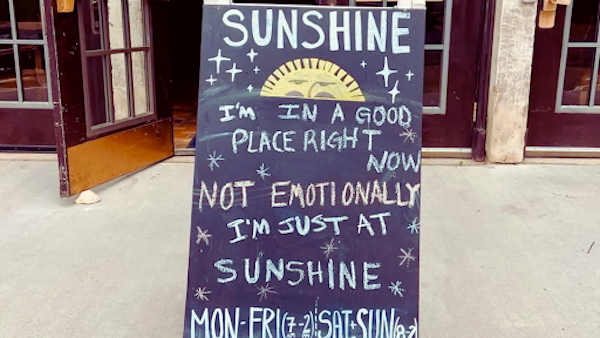Climate Art: A Forum for Re-visioning
Trisha Bauman, M.Sc., Principal at TJBauman, LLC and ISSP Governing Board President, offers how climate art allows our capacity to re-vision as a community. It enables diverse identities to come together to investigate ideas, share reflections, express feelings, and invoke imaginations: human experiences that are essential to transforming the very systems driving our polycrisis threats.
Seemingly a typical day at a public beach, crowded with people sunbathing and children playing. We observe them from above. Those below — dozens of various ages, identities, and groupings — indulge themselves in their seaside leisure of reading, playing paddle ball, picnicking, scrolling phones. From our 360-degree viewing platform, 10 meters above the sand, we are free to watch the activity, to move around the platform or sit down, to stay or leave. Most of us stay, mesmerized by the apparently innocuous scene below, while fathoming its calamitous depths. We are watching ourselves.
SUN & SEA is an opera-performance created by three young Lithuanian artists, the director Rugilė Barzdžiukaitė, librettist Vaiva Grainytė and composer Lina Lapelytė. It was the surprise masterpiece of the 2019 Venice Biennale and awarded the top prize, the Golden Lion. Since then, it has toured and performed for audiences across four continents. The piece slides us deceptively into complete immersion and, over the course of an hour, conveys how we ended up in the climate emergency we now face and, perhaps more importantly, why we are still so far from slowing it down. Over decades of viewing much of the leading works in the international contemporary arts, I would put SUN & SEA as one of the most powerful. It happens to be climate art, and we need more of this kind of brilliance in addressing the polycrisis we now face.
Climate art has developed at a slow pace over this century. In a 2005 essay on the subject, Bill McKibben lamented, "One species, ours, has by itself in the course of a couple of generations managed to powerfully raise the temperature of an entire planet, to knock its most basic systems out of kilter. But oddly, though we know about it, we don’t know about it. It hasn’t registered in our gut; it isn’t part of our culture. Where are the books? The poems? The plays? The goddamn operas? Compare it to, say, the horror of AIDS in the last two decades, which has produced a staggering outpouring of art that, in turn, has had real political effect." That has now changed, and astounding works like SUN & SEA are emerging.
Climate art can transmit the often-unseen systems in which we're enmeshed and that are driving our environmental and social emergencies. And it can offer a forum for communities to come together across their diversity to consider the views of others through a medium besides public speaking, conversation, or debate. It opens us to investigate ideas, share reflections, express feelings, and invoke imaginations in view of the accelerating crises we're traversing. Reflecting, feeling, imagining — human experiences essential to both our individual and our social capacity to transform the very systems driving our polycrisis threats.
Cultural organizations, theaters, museums, and festivals are increasingly programming what can be categorized as climate art across disciplines — theater, dance, music, visual art, poetry, film, photography, public art. The focus of these works varies, from our ecological emergency to social injustice. And the styles vary as well, some resembling a sort of cultural anthropology, like SUN & SEA, some aiming to arouse our emotional drive to take action, and some evoking the lethal future ahead if we fail at systemic change.
Museums and climate art: traversing conventional domains
Around the world, museums are focusing both programming and even their missions on these issues. The 2021 annual conference of the International Committee for Museums and Collections of Modern Art (CIMAM), an affiliate of the International Council of Museums, gathered in the Polish cities of Lodz and Gdansk to address the theme, "Under Pressure: Museums in Times of Xenophobia and Climate Emergency." The conference focused on the unexplored connections between these two crises.
Some cultural programming addresses climate and social justice through a more epistemological lens — exploring the systems, assumptions, and values that have shaped the challenges we are facing. Such programming offers communities an opportunity to encounter ideas that traverse the conventional domains of art, science, traditional and modern cultures, and civic engagement. CODE RED: Climate, Justice & Natural History Collections, an exhibition at the Maine Historical Society (MHS) in collaboration with the Portland Society of Natural History and the Gulf of Maine Research Institute, does this through a place-based view.
Curated by Tilly Laskey, an MHS curator, and Dr. Darren J. Ranco, professor of anthropology and chair of Native American Programs at the University of Maine and a member of the Penobscot Nation, CODE RED examines where Western scientific methods and Indigenous science principles overlap and diverge, bringing a central focus to the Traditional Ecological Knowledge of the Wabanaki Nations. Both the exhibition and the concurrent public programming explore issues including colonialism, geographic exploration, resource extraction, and the contribution of all of these to the climate crisis, biodiversity loss, and enduring structural injustice.
Galvanizing action through climate art
Many of today's cultural institutions present their climate and social justice programming with an explicit objective of galvanizing action. The Climate Museum in New York City, the first of its kind in the U.S., cites a 2022 study published in Nature indicating that a bipartisan American supermajority supports bold climate policy. Yet this supermajority is under the misperception that two-thirds of the U.S. population is opposed to such action. This perceptual disconnect engenders a pernicious spiral of silence and passivity that the museum aims to counter through its inclusive, equity-centered programming. The Climate Museum asserts that the popularity and trust held by museums can bring people together to learn and to join "the fight for a brighter future."
Similarly, the public programming of CODE RED explores Maine’s pivotal role in the modern environmental movement and offers ways that visitors of all backgrounds and abilities can take action for inclusive, positive change.
A space for re-visioning
Yet as critical as it is to inform and influence the action needed to change the systems driving our crises, it is just as essential for communities to have a forum for simply processing the weight of a challenge that will only intensify. Given the sharpening rise of eco-anxiety and solastalgia across global populations, and particularly among younger millennials and Gen Z, it is vital to have secular spaces where diverse identities can engage in inclusive, informed, and non-goal-oriented, reflective sharing. Our collective capacity to re-vision possibilities depends on easing the paralysis of anxiety and facilitating open, co-creative imagination. An agenda set on specific objectives can often thwart this more fertile source of possibility.
Art engenders emotion, imagination, creative insight, and social connection with a unique potency. Throughout human existence and across geographies, it is the touchstone of our community values, social constructs, and collective behaviors. Art can generate a depth and complexity of personal insight and social exchange in ways that expository media and social dialogue do not enable — and especially when the art is experienced through real-time, real-space presentation venues and live performance. It can foster the experiencing and sharing of our often undisclosed yet most consequential of human experiences: fear, uncertainty, hope, empathy, humor, connection, and joy.
In the context of the accelerating crises we face, climate art — particularly work that is place-based — can offer the cultural and psychological space for the full dimensionality of our human experience to be explored and shared. We need this secular space for any possibility of enabling systemic change. It allows our capacity to re-vision as a community — as essential a step to cultivating a regenerative future as any new approach, design, or solution.
About the Author:
Trisha Bauman, M.Sc.
Principal & Founder, TJBauman LLC
President, ISSP Governing Board
PHOTO: Wapi-kuhkukhahs or Snowy Owl basket, 2022, by Gabriel and Gal Frey, Collections of Maine Historical Society, MaineMemory.net, item 135770
Read perspectives from the ISSP blog



